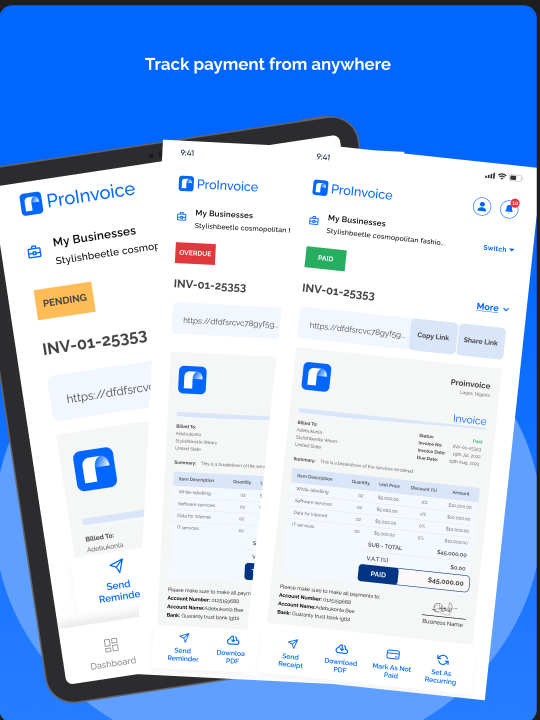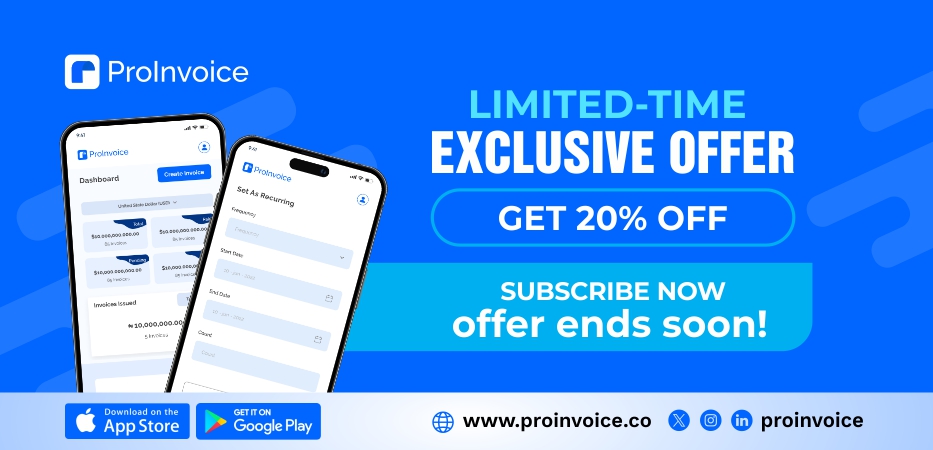Ultimate Guide to Onboarding U.S. Employees 2025: Employee onboarding for U.S. small businesses is more than paperwork it’s your competitive advantage. Companies with strong onboarding see 82% better retention and 70% higher productivity, yet only 12% of employees rate their onboarding as exceptional.
Growing teams need better tools. Try ProInvoice to simplify billing and track payments effortlessly.
What Is Employee Onboarding?
Onboarding integrates new hires into your company culture, systems, and mission. For SMEs, each onboarding experience amplifies your brand impact, making it essential for growth and retention.
10 Essential Onboarding Steps
1. Ultimate Guide to Onboarding U.S. Employees 2025- Pre-boarding Preparation
Your onboarding journey begins the moment a candidate accepts your offer, not on their first day. Start by thoroughly briefing managers and creating detailed plans for the new hire’s first week, ensuring everyone understands their role in creating a welcoming environment. Send personalized welcome messages or thoughtful gifts that reflect your company culture and assign a peer buddy from outside their immediate team who can provide informal support and help navigate unwritten organizational rules.
Complete all necessary paperwork digitally in advance and ensure their workspace, equipment, and system access are fully prepared before they arrive. This attention to detail demonstrates professionalism, reduces first-day anxiety, and builds genuine anticipation for joining your team. Pre-boarding sets the foundation for everything that follows and signals your commitment to their success from the very beginning.
2. Streamline Documentation
Efficient handling of administrative tasks sets a professional tone while freeing up valuable time for meaningful relationship-building activities. Provide comprehensive offer letters that clearly outline terms, expectations, and next steps, then share employment agreements and company handbooks digitally for easy future reference. Present your benefits packages with clear enrollment procedures and deadlines, using cloud-based systems that allow new hires to complete forms at their own pace while ensuring nothing gets overlooked.
This systematic approach significantly reduces first-day stress and demonstrates your organizational competence to new team members. For roles involving client interaction, new employees should also understand your financial processes early on, including how invoice generation works, as this knowledge helps them grasp the complete business cycle and their role within it.
3. Facilitate Team Connections
Strategic team introductions go far beyond simple name exchanges and titles—they help new hires understand how your organization truly operates. Arrange structured meetings with key stakeholders that focus on departmental relationships, dependencies, and how different roles interconnect to achieve business objectives. Schedule informal meet-and-greets, coffee chats, and team lunches that build genuine personal connections and help newcomers feel welcomed into your company culture.
These interactions should emphasize how their specific role contributes to the bigger picture and where they can turn for support, guidance, and collaboration. Make each conversation meaningful by encouraging existing team members to share their experiences and perspectives, creating a rich understanding of both formal structures and informal networks that drive success within your organization.

Proinvoice makes invoicing effortless. Use custom templates, automate reminders, set recurring bills, and track everything from one smart dashboard. Get paid faster — with less hassle.
4. Comprehensive Orientation
Deliver essential knowledge systematically through thorough safety training appropriate for their work environment, whether in-office, remote, or hybrid. Clearly define their role responsibilities, performance expectations, and success metrics while establishing communication protocols and reporting structures so they understand how information flows and decisions get made throughout your organization. Create comprehensive resource maps showing where to find support, tools, and information they’ll need for daily success.
Set realistic timelines for achieving full role competency, acknowledging that mastery takes time while maintaining appropriate performance expectations. For roles involving client management or project delivery, ensure new hires understand your complete business systems, including streamlined invoicing processes that maintain professional client relationships and demonstrate your commitment to operational excellence.
5. Understand Individual Needs
Personalization transforms generic onboarding into meaningful experiences that resonate with each individual. Take time to identify their preferred learning styles—whether visual, auditory, or kinesthetic—and adapt your training methods accordingly to maximize comprehension and retention. Discuss their career goals, professional interests, and aspirations beyond their immediate role, demonstrating genuine interest in their long-term development and success within your organization.
Schedule regular check-ins throughout their first year, using these sessions to gauge satisfaction, address concerns, and provide ongoing support and guidance. This consistent attention and investment in their individual success demonstrates that their growth matters to your organization and helps identify potential issues before they become significant problems that could impact retention or performance.
Stay organized as you grow. Use ProInvoice to manage billing and client relationships with ease.
6. Structure First Months
Create detailed roadmaps that eliminate guesswork and build confidence through clear, achievable milestones. Map out specific daily goals for their first week to provide immediate direction, then transition to weekly objectives that gradually increase in scope and complexity as they become more comfortable and capable. Develop a comprehensive 90-day plan with measurable achievements that align with both role requirements and broader company objectives.
Include projects that offer early wins and confidence-building opportunities while using regular check-in feedback to address issues proactively and celebrate progress along the way. For team members who will handle client work, provide early exposure to your billing and invoicing systems so they understand the complete project lifecycle from initial client contact through final payment processing.
7. Promote Continuous Growth
Don’t wait months to discuss development opportunities—begin conversations about professional growth and advancement immediately to demonstrate your long-term investment in their success. Introduce learning platforms, mentorship programs, and potential career paths within your organization while involving new hires in cross-functional projects where they can develop new skills while contributing meaningfully to business objectives. This approach shows that you view them as valuable assets worthy of continued investment.
Connect their daily work activities to long-term professional goals, helping them see how their current role serves as a foundation for future opportunities within your organization. This forward-thinking approach significantly increases engagement and retention while building a stronger, more committed workforce that understands their potential for growth and advancement.
8. Leverage Technology
Smart technology solutions can automate routine administrative tasks while ensuring consistency across all new hire experiences regardless of who manages the process. Use comprehensive HR software to handle system access setup, contract distribution, and task assignment automatically, freeing your team to focus on relationship-building and cultural integration activities that require human touch. Implement cloud-based tools for sharing orientation content and tracking progress systematically.
For growing businesses managing multiple client relationships, consider how integrated systems can streamline operations for new employees. Professional invoice management platforms help new team members quickly understand client workflows, billing procedures, and project management processes, ensuring they can contribute effectively to client relationships from day one while maintaining your professional standards.

Proinvoice makes invoicing effortless. Use custom templates, automate reminders, set recurring bills, and track everything from one smart dashboard. Get paid faster — with less hassle.
9. Reinforce Culture -Ultimate Guide to Onboarding U.S. Employees 2025
Company culture isn’t something new hires absorb automatically—it must be explicitly communicated and consistently demonstrated through actions and behaviors. Use storytelling, team meetings, and real-life examples to bring your organizational values to life, showing how teams collaborate effectively, how achievements are recognized and celebrated, and how feedback flows constructively throughout your organization. Share compelling stories that illustrate your company’s “why” and celebrate concrete examples of values being lived out in daily work.
Encourage existing team members to share their own experiences, perspectives, and success stories, creating a rich tapestry of cultural understanding that goes far beyond what’s written in employee handbooks. This multi-faceted approach helps new hires understand not just what you say you value, but how those values translate into actual workplace behaviors and decision-making processes.
10. Continuously Improve
Exceptional onboarding processes evolve based on systematic feedback collection and measurable results rather than assumptions about what works. Implement structured survey collection at strategic intervals—15, 30, 60, and 90 days—asking specific, actionable questions about what elements helped their integration and what areas need improvement. Compare responses across different new hires to identify patterns, trends, and opportunities for enhancement.
Track meaningful metrics including time to productivity, satisfaction scores, retention rates, and early performance indicators to assess the effectiveness of your onboarding investments. Use this data-driven approach to refine your process continuously, ensuring it remains effective and relevant as your organization grows and evolves. Remember that internal role changes also benefit from structured onboarding approaches—apply the same systematic care to cross-boarding situations.
Why Effective Onboarding Matters
The financial impact of poor onboarding extends far beyond initial disappointment—it creates costly cycles of turnover that drain resources and disrupt team dynamics. One in three new hires quit within their first 90 days, with replacement costs typically reaching 50-200% of their annual salary when you factor in recruiting expenses, interviewing time, training investments, and the productivity loss during their learning curve. These hidden costs can devastate small business budgets and momentum.
Conversely, companies with mature onboarding processes achieve remarkable results: 103% better retention rates, 82% higher engagement levels, and 70% improved productivity compared to organizations with weak onboarding systems. The data clearly demonstrates that investing in exceptional onboarding experiences pays substantial dividends in reduced turnover costs, faster time-to-productivity, and stronger team performance that directly impacts your bottom line.
Best Practices for Success
Develop a clear, comprehensive onboarding vision that defines exactly what new hires should achieve and experience during their integration period, then use this vision to guide all subsequent decisions and actions. Prioritize automation of routine administrative tasks to free up valuable time for meaningful relationship-building, cultural integration, and strategic conversations that truly matter for long-term success. Personalize experiences based on individual learning styles, career goals, and role requirements while maintaining consistent communication standards throughout the entire journey.
Ensure absolute role clarity by helping new employees understand precisely how their responsibilities contribute to team success and broader organizational objectives. Promote continuous learning and development from day one, establishing that growth doesn’t stop after the initial onboarding period ends. Having standardized business processes, including professional invoicing systems, helps new employees quickly understand operational procedures and maintain consistency across all client interactions from their first day forward.
U.S. Compliance Requirements
American businesses must navigate specific legal requirements and documentation processes when onboarding new employees to ensure full compliance with federal and state regulations. Complete Form I-9 to verify work eligibility and collect Form W-4 for accurate tax withholding purposes, while gathering essential personal information including full legal name, current address, date of birth, Social Security Number, and emergency contact details. Ensure your business maintains proper legal status with an Employer Identification Number (EIN) from the IRS and appropriate insurance coverage including workers’ compensation and general liability protection.
Maintain strict compliance with comprehensive employment laws covering contracts, working hours, minimum wage requirements, overtime regulations, and paid time off entitlements that vary by state. Follow Americans with Disabilities Act (ADA) guidelines and Equal Employment Opportunity Commission (EEOC) requirements to prevent discrimination while creating inclusive workplace practices. Handle all personal and sensitive data according to applicable federal and state privacy laws, clearly communicating data collection purposes, usage policies, storage security measures, and retention periods to build trust and ensure legal compliance.
Remote and Hybrid Onboarding
Remote and hybrid employees face unique integration challenges that require deliberate, structured approaches to overcome physical separation and limited informal interaction opportunities. They miss crucial casual conversations, spontaneous knowledge sharing, and visual cues that help office-based employees understand company culture and unwritten rules. This makes intentional relationship-building and comprehensive communication strategies absolutely essential for their successful integration and long-term engagement with your organization.
Set crystal-clear expectations around communication channels, availability windows, response times, and collaboration tools while being mindful of potential digital fatigue and meeting overload. Actively create meaningful opportunities for relationship building through virtual team socials, informal online coffee chats, structured mentorship programs, and personalized video introductions between team members. Ensure completely equal access to all company resources, training materials, benefits information, and growth opportunities from day one while encouraging healthy work-life boundaries that remote employees often struggle to maintain.
Whether you’re onboarding or expanding, ProInvoice keeps your invoicing process sharp and stress-free.
Technology Solutions
Modern onboarding software transforms traditionally time-consuming manual processes into streamlined, consistent experiences that scale effectively as your organization grows. These comprehensive platforms automate repetitive administrative tasks like welcome message distribution, form collection, digital signature processing, and system access provisioning while maintaining strict compliance with legal and regulatory requirements through secure document storage and tracking capabilities.
Advanced solutions provide engaging, user-friendly experiences through cloud-based information hubs, self-service employee portals, and automated progress tracking that gives both HR teams and managers real-time visibility into completion rates and potential bottlenecks. Choose technology solutions that integrate seamlessly with your existing business systems and support both in-office and remote employees equally, ensuring consistent quality experiences regardless of work location or arrangement preferences.
Final Thoughts
Exceptional onboarding represents a strategic investment that transforms new hires into engaged, productive team members who contribute meaningfully to your organization’s success from day one. The most successful companies recognize that onboarding extends far beyond administrative paperwork and compliance requirements—it’s about creating memorable experiences that inspire loyalty, build confidence, and establish the foundation for long-term professional relationships that benefit both the employee and the organization.
By thoughtfully combining genuine human connection with smart technology solutions and systematic processes, you create powerful experiences that significantly improve retention rates, accelerate productivity, and strengthen your company culture. The businesses that thrive in today’s competitive marketplace are those that understand onboarding as the critical first step in building the engaged, high-performing workforce that drives sustainable growth and success for years to come.
As your team grows, efficient business operations become crucial. Professional invoicing solutions help expanding teams maintain organized client relationships and consistent billing processes throughout your growth journey.














